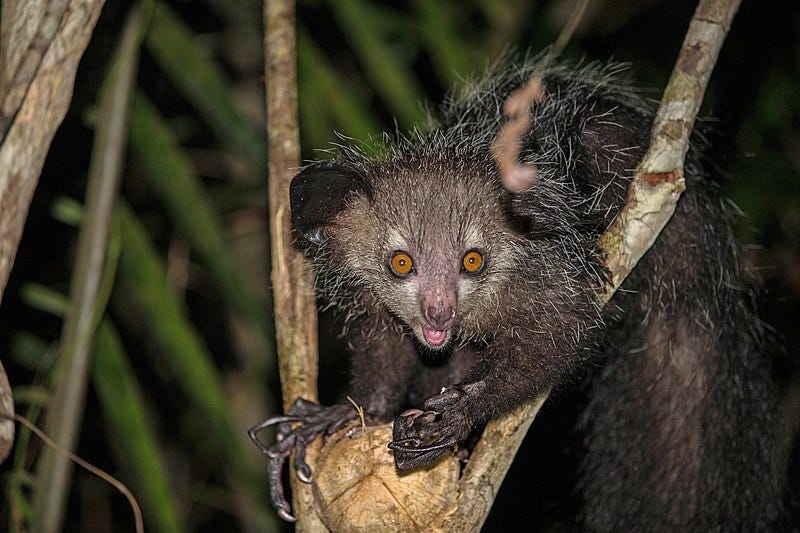The Story Behind the Strange Hands of a Strange Animal
By Dhriti Aiylam, Psychology, 2023

If one were to ask what the strangest animal out there was, the aye-aye is a strong contender. These unique little lemurs, found only on the island of Madagascar, have large yellow eyes, gigantic ears, and extremely long appendages — especially their middle finger. These fingers, which would be nine inches if they are scaled up to human size, seem to be their distinctive trait. So one can’t help but wonder: why exactly are their fingers so long?
The aye-aye’s especially long middle finger primarily helps it to find food. Aye-ayes hunt at night and rely on echolocation while using a technique called tap foraging. Here, they will tap the dead and rotting wood of trees and listen for hollows, which indicate insect tunnels intersecting under the bark. Once detected, they bite down and rip the bark open, creating a hole. Then, they will use their elongated third digit, which swivels on a ball-and-socket joint, to fish out grubs and bugs.
Aye-ayes hunt at night and rely on echolocation while using a technique called tap foraging.
Although this is certainly handy, there are caveats to having such a long finger. If the aye-aye were to use this finger for traveling, it would snap under the animal’s weight. In addition, aye-ayes have also lost the ability to grasp objects with it. That’s where their sixth digit, a “pseudo-thumb” comes in. The pseudo-thumb is a feature that was only recently discovered, as a result of all of the fascination surrounding their other fingers.
Aye-ayes and humans alike both have a muscle called the abductor pollicis longus, running down the length of the forearm and giving us the ability to stick out our thumbs. While following the aye-aye muscle, Dr. Adam Hartstone-Rose, an anatomist and lemur expert from NCSU, found that tiny tendons branched off to the aye-aye palm below the thumb and connected to a small bone called the radial sesamoid. Humans do not have a sesamoid bone on the thumb side of their hands (although we do have one on the pinkie edge of our hand). This nubby “pseudo-thumb”. made up of bone and cartilage, is manipulated by three muscles that allow it to move in three directions — and it even has its own fingerprint!
But what is the purpose of this extra appendage? Generally, when it comes to most species, scientists don’t know what role false digits play. Here, however, the pseudo-thumb seems to have a greater evolutionary significance than the famous middle finger — and this is because the thumb allows them to grasp objects and branches.
This nubby “pseudo-thumb”. made up of bone and cartilage, is manipulated by three muscles that allow it to move in three directions — and it even has its own fingerprint!
What makes the sixth digit so interesting on the aye-aye is the context in which it evolved. Firstly, the aye-aye is the only primate that naturally has a pseudo-thumb. In addition, aye-ayes developed the extra appendage because their fingers became more specialized — unlike other species who evolved pseudo-thumbs for the opposite reason. For example, in giant pandas, whose five fingers are arranged in a neat and unopposed row in order to allow them to walk, the transformation of their sesamoid bones into pseudo-thumbs arose due to the animal’s need to grasp bamboo shoots.
An aye-aye’s hand is just one of their many incredible features — they also have mammary glands between their legs and white hairs that bristle when they’re agitated. In addition, they have the largest brains relative to their body size out of all lemurs. This gives them extraordinary brain power that allows them to create mental maps of the hollow spaces within the tree trunks where they find their food. That’s why it’s disheartening to know that aye-ayes are currently endangered, and that their population is only continuing to diminish. We should strive to support conservation efforts so that, in the future, we can continue to learn more about this fascinating little creature.
Physical Anthropology (2019). DOI: 10.1002/ajpa.23936
